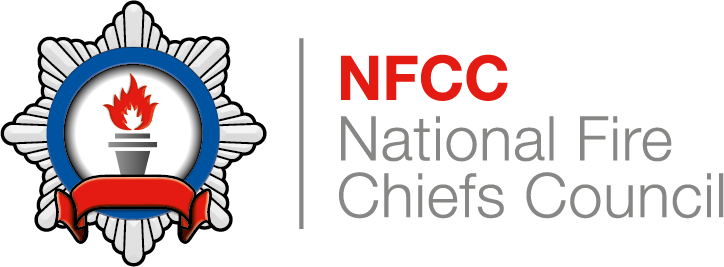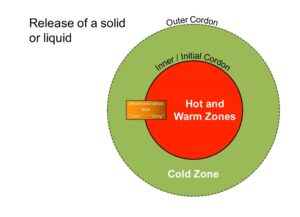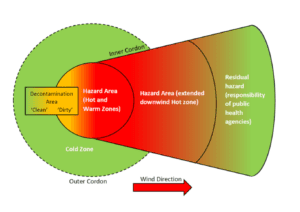Initial cordon
An initial inner cordon should be temporarily established by the first emergency responders before any detailed scene assessment has been conducted. It provides a means of controlling, safeguarding and co-ordinating the immediate response and adds an element of control to the incident. It must be flexible so that it can be expanded or reduced if necessary.
The initial cordon is an immediate precautionary measure and must be formed in a position of safety. Unprotected responders must never be deliberately deployed to a position where contamination or exposure is suspected. However, it should be considered as enclosing a potential hazard area rather than an exclusion zone. Only responders who have been briefed and equipped to deal with the hazards should be allowed to operate inside it.
Where the hazardous materials involved are toxic by inhalation, it may be necessary to extend the initial cordon in the downwind direction to protect people from vapours, gases or dusts. The initial cordon should enclose the area in which people may become incapacitated and unable to take protective action and may incur serious or irreversible acute health effects.
Beyond this area there may still be risk to the public. However, any contamination or exposure is likely to be low level where the public could take their own protective actions such as evacuation or shelter. Public health agencies have responsibility for public safety in the extended downwind area.
Areas where non-acute or possibly longer-term health risks may be present should be designated and dealt with by the public health agencies. The initial cordon must be communicated to all first responders, especially oncoming response vehicles.
Refer to Control Measure – Downwind protection zones
Hot zone
This is a contaminated area where the initial release occurs or disperses. It will be the area likely to pose an immediate threat to the health and safety of everybody in it and is the area of greatest risk. It is located inside the inner cordon and is part of the hazard area.
Effective personal protective equipment (PPE) is required when working in the hot zone. Emergency services may have differing specifications for PPE and will decide on the appropriateness of their own equipment. The effectiveness of each type of PPE for the hot zone depends on the type and concentration of the contaminant. Any decisions made should be based on a hazardous materials assessment.
There may be more than one area of release. Material may be spread or channelled, leading to more than one hot zone. Where possible all hot zones should be inside a single inner cordon. Where this is not possible for reasons of scale, location, topography etc., establishing two or more inner cordons should be considered. This may mean treating the cordoned areas as separate incidents with distinct command structures. This is more likely to happen at deliberate CBRN(e) attacks rather than an accidental hazardous materials release or spill.
Warm zone
This is the area uncontaminated by the initial release of a substance. It may become contaminated by the movement of people or vehicles. It is surrounded by the inner cordon and is part of the hazard area but usually contains lower risks than the hot zone.
In the initial stages of an incident, the movement of contamination from the hot zone to the warm zone will be uncontrolled. As soon as practicable, the warm zone needs to be managed and controlled by emergency responders wearing appropriate PPE. The warm zone will later be extended to include the managed area encompassing decontamination. This extended section of the warm zone is called the decontamination area.
At small scale, low risk, low complexity hazardous materials incidents, warm zones may not exist. Responders should not designate them if there is no benefit from doing so.
Cold zone
This is the uncontaminated area between the inner and outer cordon. Key operational command positions and other essential activities will be set up in this area. Police services, in liaison with fire and rescue services and ambulance services, should decide whether members of the public need to be evacuated from the cold zone.
Release of a solid or liquid


